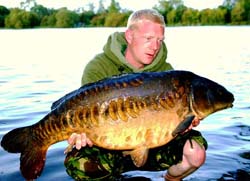Accuracy is the most important thing at any time of the year, in the past I have seen many anglers find a spot with their marker, pop it up to the surface then just cast to it which is very inaccurate as distance is very difficult to judge over water.
I can remember a time I was on one particular venue out in a boat and was watching a angler spod to his marker then cast his hook baits to it, he thought he was bang on target from the bank but as I was in line with the marker looking down the lake at a 90 degree angle I could see he was ten yards short. Now if he was on the mark that could of saved him a blank. It’s pointless spending lots of time and effort finding a feature then not being bang on the spot you have found.
Once I have found my area I am fishing to with my marker rod or a lead I then pick a feature on the far bank to aim at, for example a telegraph pole, a certain tree, not a cow or a sheep as they move! Clip the line in the line clip on the spool of the reel, that is your distance clipped up. Once I have reeled that rod in I then walk the line out, now this can be done several ways.
Here are a couple of ways to do it.
Put a peg in the ground and wrap your lead or marker float around it to secure it, then walk the line down the bank if you have room and keep going until you get to the line clip, now put another peg or bank stick in the ground level with the reel.
Now you know from one peg to the other is your distance you are fishing at. Once your marker rod (or the rod with a lead on) is reeled back in, take your fishing rod which is going to have your hook bait on and wrap your lead around the first peg.
Walk it out until your reel becomes in line with your second peg.
Make sure the line is taught between the two pegs and place the line in the clip. You then need to take some electrical tape or pole elastic and mark the line with it just in front of the clip. If you are using tape, make sure you trim it right down so it doesn’t catch the rings on the way through when casting. If you wish to use pole elastic or magic marker braid, you will need this knot to secure it. As with the tape, make sure you trim it down.
You can clip all the rods up to the same distance including your spod if you are using one and go through the same process with the tape. Remember, a spod dives down and you should clip this up a little shorter to allow for this.
Now all the lines are taped and clipped, you can aim for your marker on the far bank eg, a tall tree. Let the line hit the clip and you will be spot on your feature you have found. Each time you re-cast, put the tape back in the clip and you will always be exactly in the same spot.
If room is limited to walk the rods out another way to clip up is to place two bank sticks or pegs a rod length apart in the ground so you know they are roughly 4yards apart. I carry a piece of rope a rod length long, and secure it between the two pegs. On the rope is tape spaced out at one yard intervals, this ensures I always know how many yards I am fishing at for future reference.
Wrap your lead around the first peg and move your rod from one peg to the other, counting as you go, how many times you go around the pegs before you hit the clip. Now let’s say you went round 23 times, and got to the second piece of tape, take note of that as that is your distance you will be fishing at. Now, once you have put your feature finding rod away, take the rod you are going to fish with and go back round the pegs 23 times, to the second piece of tape. Go through the taping process the same. You are now clipped up and ready to go.
If you are unlucky enough to lose a fish or crack off, you still have your exact distance marked on the bank, ready to clip back up to.
Accuracy is one of the main factors to ensure success. If you can be precise every time, I know it will put you more fish on the bank.
,
Lee Pollard






